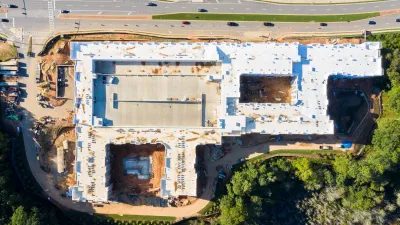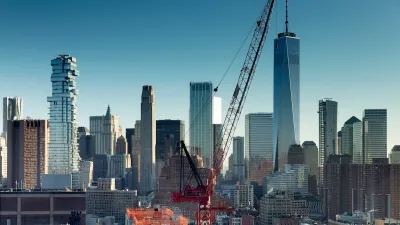I am prompted to report on this issue I came across in a news item last week. A Baptist minister in Uniontown, Pennsylvania, buried his 18-year-old son, who died three days after a car crash on July 12, in the backyard of the pastor’s church. While state law doesn’t prohibit this, some county and local ordinances do, and this county, Fayette County, only allows burials on large parcels zoned for agricultural use. The church has only five acres and is in a residential zone.
I am prompted to report on this issue I came across in a news item last week. A Baptist minister in Uniontown, Pennsylvania, buried his 18-year-old son, who died three days after a car crash on July 12, in the backyard of the pastor's church. While state law doesn't prohibit this, some county and local ordinances do, and this county, Fayette County, only allows burials on large parcels zoned for agricultural use. The church has only five acres and is in a residential zone.
I believe this is the church, courtesy of bing.com
More detailed coverage is available in the Pittsburgh Tribune-Review. Their article quotes the county planner as saying 50 acres are required. I checked the regulations. It says 50 acres. The pastor says he will apply for a variance. What will be the hardship claimed? The church faces fines of $500 a day. A court hearing is on December 7th. It's a sad, tough case.
The question really is what is an appropriate standard for small, informal burial grounds? When was the last time you looked at your burial regulations and had a discussion about them? Do they prohibit scattering of cremated remains and memorial gardens for such remains? If so, why? There may be good reasons, such as the ease in removing and relocating remains. See the ordinances cited below.
The Pennsylvania Association of Township Supervisors has some guidance on-line, but no suggested regulations. Click here. People in Mountain Home, Idaho, talked about these issues last year. Elmore County, where Mountain Home is located, changed its regulations to allow backyard burials under certain conditions. Go here to read it. It has the basics and is worth considering.
The New York Times had a detailed story on home burials this last summer. Here's an attractive homemade coffin pictured in that article that you can use as a bookcase until needed.
Courtesy The New York Times
These situations are not all that unusual. Last year, a woman buried her husband in the back yard of their home in Chester, Connecticut. Elsie Piquet and her husband pledged to each other they would never part, even after death. He died, but she found out that unfortunately there were no available grave sites side-by-side in Chester. So, she got a local funeral director and had him bury the casket in their backyard. Here, courtesy of bing.com, is an aerial of the house at 28 South Wig Hill Road. Look carefully
Chester is a rural town and it reminds me of Vermont. Now there's a state that knows something about backyard burials. The Vermont Department of Health website has this guidance: "Families in Vermont may care for their own dead [1973 Assistant Attorney General opinion] and this includes transporting the deceased, burial on private property, and/or cremation. Vermont law does not require embalming, but you should consider weather and reasonable planning so that disposition is carried out in a timely manner." See http://healthvermont.gov/vadr/burial/home.aspx.
Here's some other handy guidance:
"If you live outside the village or city limits, you can usually create a family burial ground on your own land. The site should be 150 feet from a water supply (100 feet from a drilled well) and 25 feet from a power line. Avoid areas with a high water table. It's also a good idea to bury at least 20 feet from the setback on your property."
I can see why it's not a good idea to bury a person near a drinking water well, but tell me what the issue is with the power line unless it's a backhoe hitting it?
Note the mention of weather. My family is from Vermont, I have a home there, and I teach at Vermont Law School. Let me tell you, no where else in this country do people spend more time on the weather than in Vermont. You really should listen to Mark Breen and Steve Maleski's "Eye on the Sky" weather reports on Vermont Public Radio with web streaming. Go to this site, look for the box entitled "Options" and click on "Eye on the Sky Forecasts." Then click on "listen," then go to "comprehensive forecast" and click on "listen." I promise, it will be worth the effort. You'll get three credits in meteorology just for listening. See also http://www.vermontguides.com/2002/11-nov/eyeonthesky.htm.
The zoning enforcement officer issued a cease-and-desist order. The case went to trial. Elsie Piquet lost. The court found that the Chester zoning regulations are permissive in nature and those uses not specifically permitted are prohibited. This type of regulation is to be compared with regulation characterized as prohibitive zoning "where all uses are allowed except those expressly prohibited." Permissive zoning regulations are the predominant type in Connecticut.
The court granted the town's motion for summary judgment in part on the interpretation of the regulations and in part because the plaintiff did not submit any evidence in support of her claim that the burial should be considered an accessory use. Click here for a copy of the decision.
I asked the town's attorney, my friend John S. Bennet, of Gould, Larson, Bennet, Wells and McDonnell in Essex, Connecticut, about the status of the case. He replied: "It turns out the case is not dead yet. An appeal has been timely taken. I have the paperwork buried here someplace. Let me know if you need any of it and I will try to exhume it from the file for you and send it along."
"Natural burial" is emerging – sustainability, if you will, when life is no longer sustainable. Natural burial began, according to the Centre for Natural Burial, in the United Kingdom in 1993. See http://www.naturalburial.coop/.

Study: Maui’s Plan to Convert Vacation Rentals to Long-Term Housing Could Cause Nearly $1 Billion Economic Loss
The plan would reduce visitor accommodation by 25,% resulting in 1,900 jobs lost.

North Texas Transit Leaders Tout Benefits of TOD for Growing Region
At a summit focused on transit-oriented development, policymakers discussed how North Texas’ expanded light rail system can serve as a tool for economic growth.

Using Old Oil and Gas Wells for Green Energy Storage
Penn State researchers have found that repurposing abandoned oil and gas wells for geothermal-assisted compressed-air energy storage can boost efficiency, reduce environmental risks, and support clean energy and job transitions.

How Madison’s Tree Planting Efforts Are Growing a Healthier Community
Madison’s annual tree planting initiative is enhancing environmental resilience, public health, and community livability by adding 1,400 carefully selected trees citywide, with strong community and institutional support for urban forestry.

Texas State Bills Could Kill Transit Funding in Dallas, Austin
State lawmakers could pull funding from the state’s largest transit agency and the ambitious Project Connect, a voter-approved transit project in Austin.

Opinion: DC Encampment Sweeps Hide, but Don’t Solve, Homelessness
President Trump recently ordered the clearing of encampments built by unhoused people on federal land in Washington, D.C.
Urban Design for Planners 1: Software Tools
This six-course series explores essential urban design concepts using open source software and equips planners with the tools they need to participate fully in the urban design process.
Planning for Universal Design
Learn the tools for implementing Universal Design in planning regulations.
Ascent Environmental
Borough of Carlisle
Institute for Housing and Urban Development Studies (IHS)
City of Grandview
Harvard GSD Executive Education
Toledo-Lucas County Plan Commissions
Salt Lake City
NYU Wagner Graduate School of Public Service

































